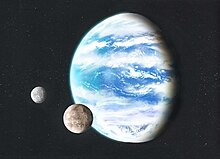User:Drbogdan/sandbox-HyceanPlanet
ALSO SEE => SUBPAGES
HYCEAN PLANET - DRAFT - WORK IN PROGRESS - 20210826
https://en.wikipedia.org/wiki/Hycean_planet
DISCUSSION => DELETED - 20211211
https://en.wikipedia.org/wiki/Wikipedia:Articles_for_deletion/Hycean_planet
ARCHIVES - Hycean planet - 20210831
- https://web.archive.org/web/20210831150758/https://en.wikipedia.org/wiki/Hycean_planet
- https://web.archive.org/web/20210831150954/https://en.wikipedia.org/wiki/Talk:Hycean_planet
- https://archive.ph/wip/PD9pi - Hycean planet
- https://archive.ph/wip/nby2d - TalkPage (20210831)
ARTICLE VERSION - 15:10, 04 December 2021

A hycean planet − from the words hydrogen and ocean
Hycean planets can be "significantly larger compared to previous considerations for habitable planets, with radii as large as 2.6 R⊕ (2.3 R⊕) for a mass of 10 M⊕ (5 M⊕)".[2] Also, the habitable zone (HZ) of such planets may be "significantly wider than the terrestrial-like HZ". The related planetary equilibrium temperature may be as high as about 500 K (227 °C; 440 °F) "for late M dwarfs".[2]
Further, tidally locked planets may be "Dark Hycean" worlds ("habitable conditions only on their permanent nightsides") or "Cold Hycean" worlds (involving "negligible irradiation").[2] Hycean planets may soon be studied for biosignatures by terrestrial telescopes as well as space telescopes, such as the James Webb Space Telescope (JWST) scheduled to be launched later in 2021.[2]
History
The notion of a hycean planet was first presented in August 2021 by astronomers at the Institute of Astronomy, University of Cambridge, based on studies involving planet atmospheres, densities and related properties (masses, radii and temperatures), including potential habitability, as well as habitable zones related to host stars, and the ability to detect biosignatures in such worlds.[2]
See also
References
- ^ a b Anderson, Paul Scott (29 August 2021). "Hycean planets might be habitable ocean worlds". Earth & Sky. Retrieved 29 August 2021.
- ^ doi:10.3847/1538-4357/abfd9c. Retrieved 27 August 2021.)
{{cite journal}}: CS1 maint: unflagged free DOI (link - ^ a b Davis, Nicola (25 August 2021). "'Mini-Neptunes' beyond solar system may soon yield signs of life - Cambridge astronomers identify new hycean class of habitable exoplanets, which could accelerate search for life". The Guardian. Retrieved 27 August 2021.
External links
- Video (3:38) – Hycean planets (26 August 2021)
Category:Hypothetical planet types
*
ARTICLE VERSION - 08:33, 30 August 2021

A hycean planet - from the words hydrogen and ocean
Hycean planets can be "significantly larger compared to previous considerations for habitable planets, with radii as large as 2.6 R⊕ (2.3 R⊕) for a mass of 10 M⊕ (5 M⊕)".[2] Also, the habitable zone (HZ) of such planets may be "significantly wider than the terrestrial-like HZ". The related planetary equilibrium temperature may be as "high as ∼500 K for late M dwarfs".[2]
Further, tidally locked planets may be "Dark Hycean" worlds ("habitable conditions only on their permanent nightsides") or "Cold Hycean" worlds (involving "negligible irradiation").[2] Hycean planets may soon be studied for biosignatures by terrestrial telescopes as well as space telescopes, such as the James Webb Space Telescope (JWST) scheduled to be launched later in 2021.[2]
See also
References
- ^ "EarthSky | Hycean planets might be habitable ocean worlds". earthsky.org. 29 August 2021. Retrieved 29 August 2021.
- ^ doi:10.3847/1538-4357/abfd9c. Retrieved 27 August 2021.)
{{cite journal}}: CS1 maint: unflagged free DOI (link - ^ a b Davis, Nicola (25 August 2021). "'Mini-Neptunes' beyond solar system may soon yield signs of life - Cambridge astronomers identify new hycean class of habitable exoplanets, which could accelerate search for life". The Guardian. Retrieved 27 August 2021.
External links
- Video (3:38) – Hycean planets (26 August 2021).
Category:Hypothetical planet types
*
{{astronomy-stub}
ARTICLE VERSION - 20:33, 28 August 2021

A hycean planet is a hypothetical type of
See also
- Desert planet
- Earth analog
- K2-18b
- MERMOZ
- Ocean planet
References
- ^ doi:10.3847/1538-4357/abfd9c. Retrieved 27 August 2021.)
{{cite journal}}: CS1 maint: unflagged free DOI (link - ^ University of Cambridge (25 August 2021). "New class of habitable exoplanets represent a big step forward in the search for life". Phys.org. Retrieved 27 August 2021.
- ^ Davis, Nicola (25 August 2021). "'Mini-Neptunes' beyond solar system may soon yield signs of life - Cambridge astronomers identify new hycean class of habitable exoplanets, which could accelerate search for life". The Guardian. Retrieved 27 August 2021.
- ^ Carter, Jamie (25 August 2021). "Is Alien Life Hiding In Plain Sight? New Class Of 'Hycean' Planet Is Where We Should Look, Say Scientists". Forbes. Retrieved 25 August 2021.
- ^ Starr, Michelle (26 August 2021). "We Could Discover Alien Life on This New Class of 'Hycean' Exoplanets, Study Says". ScienceAlert. Retrieved 27 August 2021.
- ^ Wall, Mike (26 August 2021). "Alien life could thrive on big 'Hycean' exoplanets - Hycean planets are up to 2.5 times bigger than Earth, with oceans and hydrogen-rich atmospheres". Space.com. Retrieved 27 August 2021.
- CNN News. Retrieved 27 August 2021.
- ^ Irving, Michael (26 August 2021). "Say hi to Hycean worlds, a new class of exoplanet that could host life". NewAtlas.com. Retrieved 27 August 2021.
- ^ Staff (26 August 2021). "Astronomers Identify New Class of Exoplanets: Hycean Worlds". Science News. Retrieved 27 August 2021.
- ^ a b Staff (27 August 2021). "Alien life could be living on big 'Hycean' exoplanets". BBC News. Retrieved 27 August 2021.
- ^ Cohen, Liz (27 August 2021). "Scientists may find life on Earth-like planets covered in oceans within the next few years". CBS News. Retrieved 28 August 2021.



